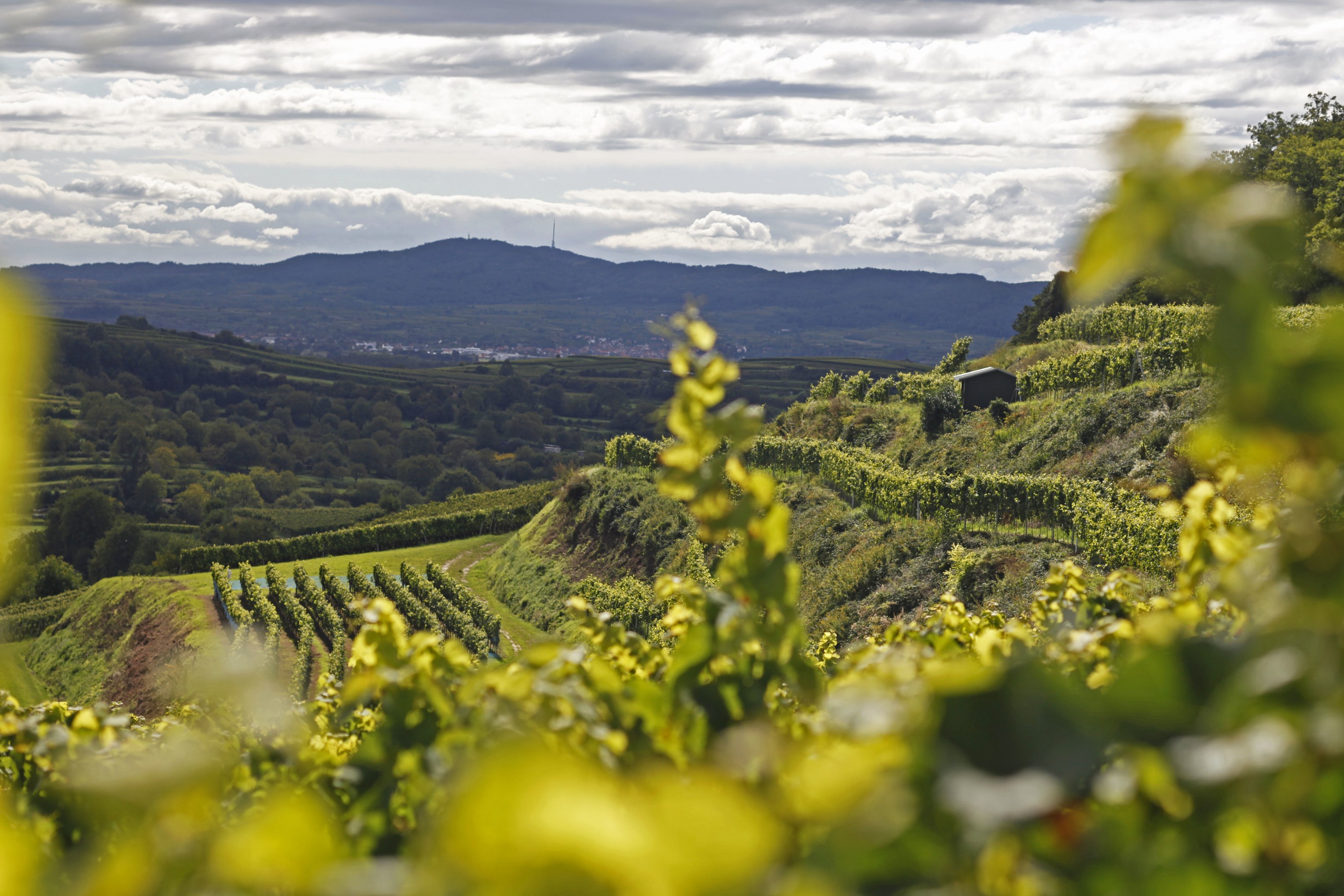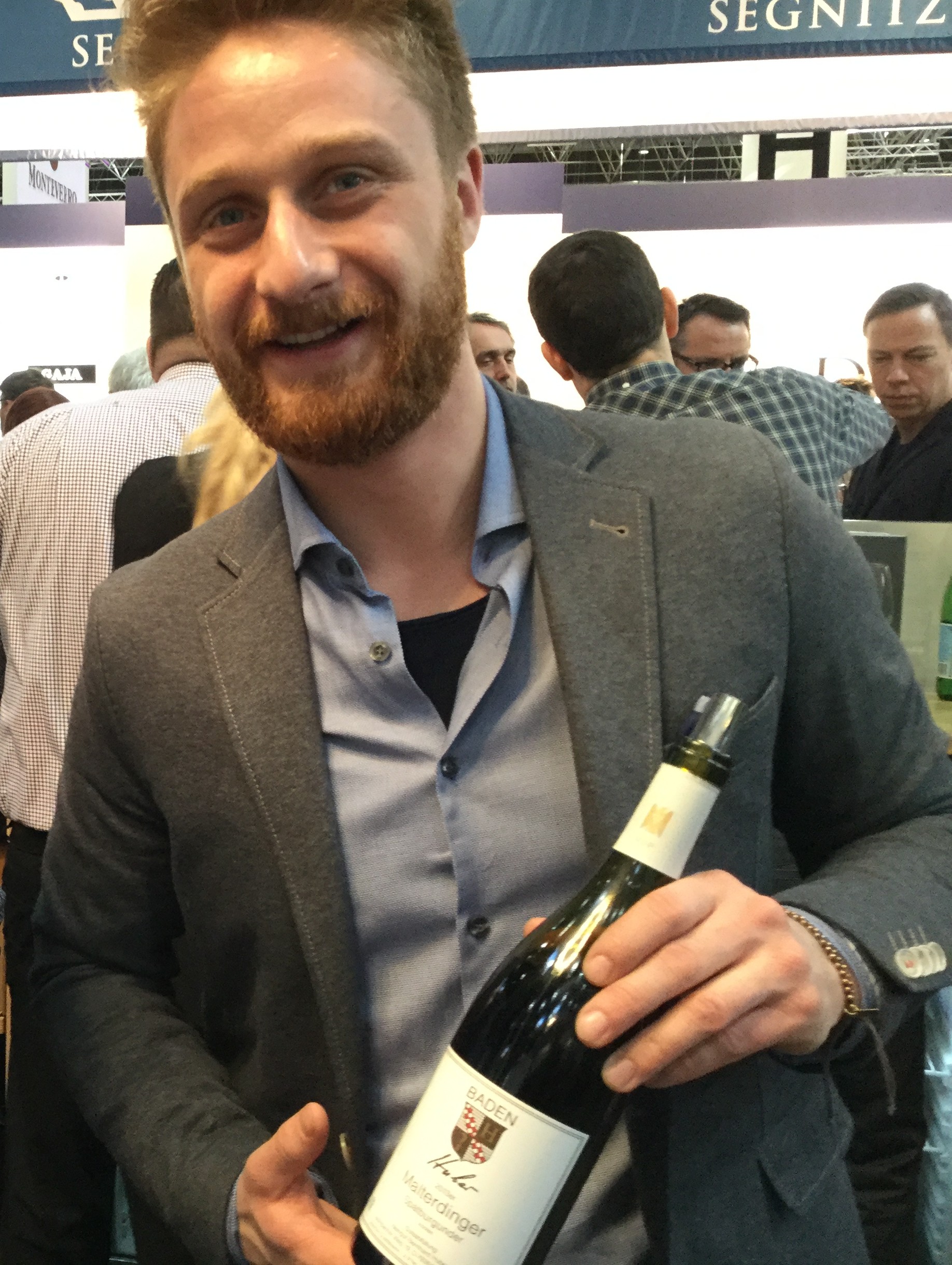 It was a joy to meet Julian Huber in Europe in March. He’s a fine gentleman in the mould of his father, and it’s clear his wines would make the late, great Bernhard Huber proud. Bernhard, who died in June 2014, did so much to awaken the world’s attention to Baden’s potential for great Pinot Noir. He was a “universal genius” according to the Gault Millau German Wine Guide. He loved Malterdingen and his part in shining a contemporary light on an area blessed with a long but little-known Pinot history. That this tradition – begun in the 1200s by Cistercian monks from Burgundy – is being enriched by another Huber with genius in his blood, is something to celebrate.
It was a joy to meet Julian Huber in Europe in March. He’s a fine gentleman in the mould of his father, and it’s clear his wines would make the late, great Bernhard Huber proud. Bernhard, who died in June 2014, did so much to awaken the world’s attention to Baden’s potential for great Pinot Noir. He was a “universal genius” according to the Gault Millau German Wine Guide. He loved Malterdingen and his part in shining a contemporary light on an area blessed with a long but little-known Pinot history. That this tradition – begun in the 1200s by Cistercian monks from Burgundy – is being enriched by another Huber with genius in his blood, is something to celebrate.
Julian started working alongside Bernhard in 2008. Four years later, during his final year of study at Geisenheim, his father found out he was seriously ill. That’s when the reins effectively passed from Germany’s “wizard of Pinot Noir” to his apprentice. These 2013 wines are an excellent reflection of Julian’s foundations and intent. There’s greater subtlety and the oak has retreated further into the background. The wines still have the same vitality and raw fruit power, but they’re a touch more restrained and – if you will – Burgundian.  The true stamp of these wines, though, is Huber. They’re recognisable to us as they’ve become a cherished part of our portfolio and our drinking regimen. It’s tremendous to see that they’ve been embraced by so many others here, too. This has been furthered by a great showing at such events as the Mornington Peninsula International Pinot Noir Celebration and SIPNOT, and by the effusive affection of James Halliday. The great Australian wine oracle was even moved last year to pen an article based on them, bearing the title: “German Pinot Noir – why you need it in your life”. In his tasting of the 2012s, Halliday commented on hitting the first grand cru: “As you ascend the steps of the quality ladder of Huber, the quality of each wine seems to be incapable of being overtaken, but it is.” As if to prove the point, he then encountered the Schlossberg and wrote: “Improbably, there is another level, here in unassailable Grand Cru country, a toss-up between Vosne-Romanée and Gevrey-Chambertin, with echoes of each.”
The true stamp of these wines, though, is Huber. They’re recognisable to us as they’ve become a cherished part of our portfolio and our drinking regimen. It’s tremendous to see that they’ve been embraced by so many others here, too. This has been furthered by a great showing at such events as the Mornington Peninsula International Pinot Noir Celebration and SIPNOT, and by the effusive affection of James Halliday. The great Australian wine oracle was even moved last year to pen an article based on them, bearing the title: “German Pinot Noir – why you need it in your life”. In his tasting of the 2012s, Halliday commented on hitting the first grand cru: “As you ascend the steps of the quality ladder of Huber, the quality of each wine seems to be incapable of being overtaken, but it is.” As if to prove the point, he then encountered the Schlossberg and wrote: “Improbably, there is another level, here in unassailable Grand Cru country, a toss-up between Vosne-Romanée and Gevrey-Chambertin, with echoes of each.”
It’s no secret that we too are enormously proud to be associated with Huber. It is with great pleasure that we present Malterdingen’s new generation.
THE 2013s
2013 Huber Weissburgunder RRP $48
2013 Huber Malterdinger Pinot Noir RRP $62
MAGNUM RRP $136
From vines up to 25 years of age, with deeper roots, 30 to 35% whole bunch. After harvesting the grapes with a crop round about 55 hl per ha, this wine matures for 12 months in three- and four-year-old barriques. The Malterdinger is Huber’s village wine.
2013 Huber Alte Reben Pinot Noir RRP $93
MAGNUM RRP $200
Huber’s Alte Reben can be thought of as the estate’s Premier Cru. This Pinot comes from vines of up to 40 years old. The estate harvests the Alte Reben at 37 hl/ha. The ferment contains 35 to 40% whole bunches. This wine is bottled unfiltered. It has complex, deep aromas of chocolate but also soft tannins, a frisky-elegant character with a fine persistance.
THE 2013 GRANDS CRUS
2013 Huber Sommerhalde Pinot Noir Grosses Gewächs RRP $128
MAGNUM RRP $288
Situated on the eastern edge of the Breisgau vineyards, the Sommerhalde vineyard lies next to the Black Forest. It’s a southeast-facing site with reddish ferruginous soil streaked with veins of shell limestone, with very good water-holding capacity. Sommerhalde covers 40 hectares, of which Huber owns 2.15 ha, all of which are classified Grosses Gewächs. It sits at an altitude of 240-300m above sea level and has a slope of between 20% and 50%. Planting density of the old plants is 4,500 vines/ha, while the new plantings are between 7,000 and 9,000 vines/ha. Cool night winds caress the grapes and give them great fruitiness. The south eastern location and the day’s first rays of sun dry the grapes very quickly, which is ideal for Pinot Noir. Average yields for Pinot Noir are 30 hl/ha. The vineyard typically gives great fruit with clear, lively hints of dark berries and plenty of minerality.
The Sommerhalde charms with a seductive perfume of exotic spices, orchard blossom and fine cigar smoke. On the palate things get a little more intense with lashings of fleshy plums and juicy morello cherries making the early running, only to be reined in by flavours of dark chocolate, dust from the grindstone, roasted hazelnuts and a subtle mix of herbs and spices. Still youthful, but already very elegant. 18/20 Michael Schmidt jancisrobinson.com
2013 Huber Bienenberg Pinot Noir Grosses Gewächs RRP $128
MAGNUM RRP $288
Huber’s holdings in the Bienenberg vineyard were planted in the 50s and 60s with primarily German clones. They are the oldest on the estate. Of the approximately 130-hectare Bienenberg Vineyard, Huber owns 15 hectares. Of this, about 10.45 ha is classified Grosses Gewächs. The soil is yellow-reddish shell limestone. The aspect is south-east to south-west. Part of the vineyard is on a 15% slope and part is on small, steeply ascending terraces (up to 60% gradient). The average vine age is between two and 53 years and yields are around 30 hl/ha. The Pinot Noir is marked by red fruits with hints of violets. Equipped with power and elegance, it takes time to play out its potential.
Quite reserved in its fragrance, the Bienenberg nevertheless grants delightful glimpses of bramble, blackberries and bonfire smoke. The palate is far more generous and reflects the Bienenberg’s proximity to the Black Forest by a gateau-like richness of sweet cherries, but although the fruit is juicy and the texture creamy, assertive tannins and healthy acidity make sure that the wine is not lacking in structure. 17.5/20 Michael Schmidt, jancisrobinson.com
2013 Huber Schlossberg Pinot Noir Grosses Gewächs RRP $160
MAGNUM RRP $336
Bright yellowish limestone par excellence. Schlossberg is considered the most concise vineyard in Breisgau and has been used for viticulture since 1492. It’s a steep slope on a gradient of up to 72% (in the Kapelleberg part up to 96%). It requires purely manual work and the mineral, skeleton-rich soil with bright yellowish limestone is geologically rare within the Black Forest foothills. The main orientation is south to south west. It’s an absolutely top location for Pinot Noir and Chardonnay. Of the vineyard’s 50 hectares, Huber’s holdings are 6 ha, of which 5.49 ha are classified as Grosses Gewächs. The 6- to 35-year-old vines are planted with a density 6,250-13,000 vines/ha. The yield here is 28 hl/ha. The steep slope makes for very intense sun radiation. The wines have great inner warmth and depth, a firm structure, pronounced minerality and strong fruit.
None of Huber’s Grosse Gewächse are short of fruit, but although the Schlossberg exhibits its fair fragrance of plums and blackberries, they merely act in support of a darker and deeper minerally expression. Shaved pencil, graphite and forest undergrowth represent a most intriguing and almost mysterious composition of aromas. On the palate the fruit of dark berries insists on its juicy ways, supported by fine spices, but then a cool stony notion takes command. Compact structure, full body and firm grip demand to be given time to agree on harmony. 18/20 Michael Schmidt, jancisrobinson.com
2013 Huber Wildenstein Pinot Noir RRP $310
The name means “Wild Stone”, and the site is distinguished by small terraces, some of which have ancient, dry stone walls. Pinot Noir was brought here 700 years ago by Cistercian monks from Burgundy. The soil is reddish from iron deposits with some very rocky ground, forcing the vines to root deeply and providing useful trace elements and minerals which are reflected in the wines. The planting density is between 5,000 and 10,000 vines/ha. This deeply mineral, finely structured wine is the greatest expression of Pinot Noir from Huber, and has the greatest aging potential.
Elegant nose with the purity of Schwarzwälder Kirschwasser (German equivalent of the finest of eau-de-vie-de-cerises), sweet cherries and a dusting of dark chocolate. Fragrant nuances of cedar spice, cloves and the smoke of exquisite cigars drift above the glass. On the palate plums and cherries in cognac bring great generosity of fruit to the flavour, but a subtle contribution of barrique prevents blurring of the edges. Spicy and smoky notes add further intrigue. The complex taste profile is well supported by a harmonious alliance of healthy acidity and unobtrusive tannins. 18.5/20 Michael Schmidt jancisrobinson.com
OTHER WINES
2012 Huber Pinot Noir RRP $47
Bright colour, not especially deep; crystal clear varietal character foretells a pure pinot, with a linear mouthfeel to its dark cherry fruit until a savoury twist on the finish adds another dimension and length. 94 points. James Halliday
2012 Huber Malterdinger Pinot Noir 375ml RRP $35
MAGNUM RRP $136
Good colour; Huber grows and makes pinot of world class; the bouquet is fragrant and very expressive, hinting at the cherry and plum fruit that has a juicy succulence as it rolls over the back-palate and into the finish and aftertaste. 95 points. James Halliday
2003 Huber Pinot Noir Alte Reben RRP $136
This old-vine Pinot Noir was made in the last vintage before Bernhard Huber began bottling his best vineyards separately, and thus marks the estate’s pinnacle from that time.